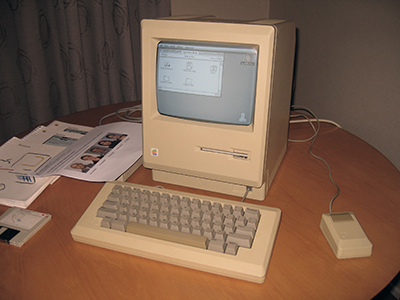| Tweet |
Apple Macintosh 128 (The original "Apple Mac")

(Note: Click on the image for a larger view. I also describe this machine in a YouTube video)
The year was 1984. IBM and IBM compatibles were starting to dominate the business market. Meanwhile low-cost (and low margin) home computers of every type, largely incompatible with one another, sloshed around bedrooms and lounges training up the next generation of IT specialists.
Where was Apple Computers at this time? Well, the wheels had not come off but they were starting to wobble. The unreliable Apple III had been a debacle and the innovative Lisa just too expensive to gain traction. Apple was saved from drowning in red ink by the Apple IIe which, although hardly ground-breaking, was proving to be a profitable and steady seller.
Steve Jobs wasn't worried. He was convinced his next baby would be a winner and he poured all of his boundless passion into it. With the Macintosh, he envisaged an “appliance” computer. This was a one you never needed to open or upgrade. It would just “work” intuitively. Furthermore it would be funky, fun and just plain “cool”. A subversive computer, which would free workers from the boring mundane shackles of the IBM/PC-DOS world. Using George's Orwell's book “1984” as a metaphor, Jobs said as much in this 1984 Superbowl advertisement.
Despite Job’s bravado the Apple Macintosh 128 failed to crack the business market. While the design was eye-catching and the graphical user interface (GUI) way more intuitive than the PC/MS-DOS environment, there was little software for the machine. Also, the sparse 128k memory meant many thumb-twiddling disk accessing moments when the machine was in use. In fact, the look and feel of the computer may have worked against it in the business market. It seemed more like a cutesy toy than a “serious” computer. The IBM XT or AT on the other hand; now those rugged boxes obviously meant business.
Jobs, deep in his “reality distortion field”, refused to accept the Macintosh wasn’t succeeding in the marketplace. This angst was one of the major reasons for his parting of the ways from Apple Computer in 1985.
Even though it flunked business 101, the Macintosh did not die. Through upgrades and hard disk-capablity the Macintosh models cornered a small but steady segment of the late 1980’s computer market specialising in desktop publishing, graphic design and education. They were also popular with academics and writers.
The Mac introduced the common man (and woman) to mice and GUIs forcing the industry to follow suite.
It took me a few years looking to find this first Macintosh model. When I found the example you see here I was stoked!. Although the case is somewhat sun-weathered (but not as bad as the photo would suggest), the machine works and is complete with the User, MacPaint and MacWrite manuals. There are original disks for the latter two programs too!
Although the case and mainboard is "original Macintosh", upgrades have been fitted. The unit has been modified internally to 512k RAM and contains MacPlus ROMS. Also it's been fitted with a 800k floppy drive. As far as functionality is concerned then, it is the same as a 512ke model. Not to worry though, it's a classic computer by anyone's definition!
Update: The Mac 128 found a new owner in July, 2024 so is no longer with me.
Want to know more about this micro? Google is your friend.
This page last edited 8th July, 2024
| Tweet |